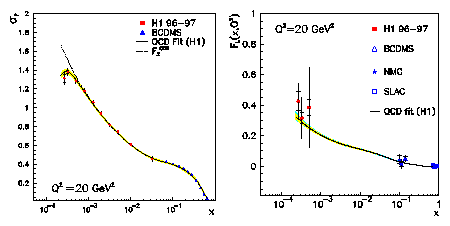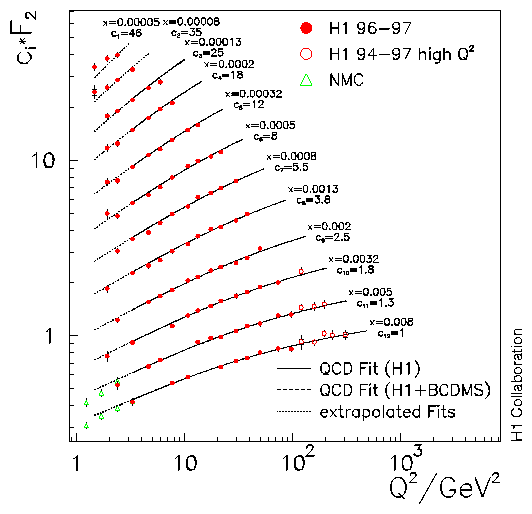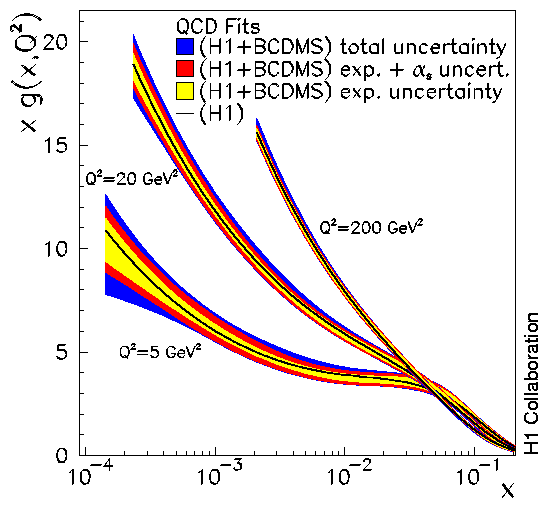Deep-inelastic Inclusive ep Scattering at Low x and a
Determination of alphas
|
High energy, ie. deep-inelastic, electron proton collisions are the
cleanest ways to study the inner structure of the proton. The electron can
probe the proton and its constituents via the electromagnetic interaction,
much in the spirit of the famous Rutherford experiment which established
the modern picture of the atom. The electrons thereby send virtual photons
towards the proton scanning its internal structure like an electron
microscope renders the image of an object.
 Figure 1: Measurement of the "reduced" deep-inelastic scattering
cross section (left), here given for example at Q2=20 GeV2 by the H1
experiment at low x (solid points) and by the fixed target µp
experiment BCDMS at larger x (triangles). The curves represent the QCD
calculation of the cross section (solid) and of the structure function
F2 (dashed) which in most of the x range is
identical to the cross section. At lowest x the cross section is lower than
F2 which is attributed to the longitudinal
structure function FL. From the difference
of the data points and the calculated, extrapolated F2 a measurement of FL
is derived (right).
Figure 1: Measurement of the "reduced" deep-inelastic scattering
cross section (left), here given for example at Q2=20 GeV2 by the H1
experiment at low x (solid points) and by the fixed target µp
experiment BCDMS at larger x (triangles). The curves represent the QCD
calculation of the cross section (solid) and of the structure function
F2 (dashed) which in most of the x range is
identical to the cross section. At lowest x the cross section is lower than
F2 which is attributed to the longitudinal
structure function FL. From the difference
of the data points and the calculated, extrapolated F2 a measurement of FL
is derived (right).
By using large scale detectors, the HERA collaborations measure the
inclusive deep-inelastic scattering cross section amounting to a
measurement of the rate at which the beam electrons recoil from the quarks
inside the protons. This rate depends on the photon virtuality
Q2 and on the fraction of proton
momentum x carried by the struck quark. Due to the colliding beam
kinematics, HERA has extended the range explored in deep-inelastic
scattering by orders of magnitude into the new region of extremely low
x. This paper presents a first precise measurement of this
scattering cross section and confronts it with the expectation from Quantum
Chromodynamics (QCD), a modern field theory, which describes strong
interactions as the exchange of coloured gluons between quarks inside the
proton.
The unknown proton structure is measured by two structure functions,
F2 and FL, which correspond to different polarisation
states of the exchanged virtual photon. While the structure function
F2 in a large part of the measured
kinematic region is identical to the deep-inelastic scattering cross
section itself, the determination of FL is experimentally much more challenging. Its
effect is seen for example in figure 1 (left), where the deviation of the
measured cross section points from the extrapolation of F2 (dashed line) signals the onset of the
contribution by the longitudinal structure function FL. The derived data points on FL are shown in figure 1 (right) demonstrating
again the large extension of the kinematic range.
The photons which mediate the electromagnetic interaction do not couple
directly to electrically neutral gluons but to charged quarks. However, the
presence of gluons inside the proton can be felt by the struck quark. At
large quark momenta x, quarks can have lost sizable momentum by
radiating gluons prior to the interaction with the virtual photon. Gluons
can produce pairs of sea quarks which enhances the amount of quarks
available for interaction with the photon at low momenta x. These
processes can be resolved if the resolution of the photon probe, determined
by its virtuality Q2 is sufficiently
large. The amount of quark scattering partners is thus expected to increase
with Q2 , i.e. at low x the
structure function F2(x,Q2) should rise with Q2, and this rise is determined by the gluon
momentum distribution. As can be seen in figure 2, these so-called scaling
violations are indeed observed and they are well described by the
theoretical calculation using QCD.
 Figure 2: Measurements of the proton structure function
F2(x,Q2) by
the H1 and the NMC experiments. Solid curves indicate the QCD expectations.
Dotted curves show fit extrapolations at fixed x into the region below
Q2=3.5 GeV2
Figure 2: Measurements of the proton structure function
F2(x,Q2) by
the H1 and the NMC experiments. Solid curves indicate the QCD expectations.
Dotted curves show fit extrapolations at fixed x into the region below
Q2=3.5 GeV2
Through the production of sea quarks, the distribution of gluons becomes
thus measurable. Figure 3 shows the gluon distribution for three values of
Q2. As can be seen, the gluon
distribution rises dramatically towards low values of x reflecting
the strong Q2 dependence of
F2. At some point, this rise towards
low x must come to an end since only a finite number of gluons can
be accommodated in a proton. This, however, has not been observed yet, and
it is to be seen in future accelerator experiments where a damping of this
rise may set in.
In any field theory the coupling constant determines the strength of the
interaction. Over three decades it has been attempted to accurately measure
the strong interaction coupling constant alphas. In the last
part of this paper a phenomenological analysis is presented leading to one
of the most precise determinations of alphas obtained so far.
This accuracy is not surprising given the large kinematic range of the new
HERA data combined with the BCDMS data, the high precision of these
measurements and the theoretical advantages of inclusive deep-inelastic
scattering for testing Quantum Chromodynamics.
 Figure 3: Gluon distribution resulting from the QCD
fit to H1 ep and BCDMS µp cross section data. The innermost error
bands represent the experimental error for fixed alphas=0.1150.
The middle error bands include in addition the contribution due to the
simultaneous fit of alphas. The outer error bands also include
the uncertainties related to the QCD model and data range. The solid lines
inside the error band represent the gluon distribution obtained in the fit
to the H1 data alone.
Figure 3: Gluon distribution resulting from the QCD
fit to H1 ep and BCDMS µp cross section data. The innermost error
bands represent the experimental error for fixed alphas=0.1150.
The middle error bands include in addition the contribution due to the
simultaneous fit of alphas. The outer error bands also include
the uncertainties related to the QCD model and data range. The solid lines
inside the error band represent the gluon distribution obtained in the fit
to the H1 data alone.
Last Update 11.12.2000
 Figure 1: Measurement of the "reduced" deep-inelastic scattering
cross section (left), here given for example at Q2=20 GeV2 by the H1
experiment at low x (solid points) and by the fixed target µp
experiment BCDMS at larger x (triangles). The curves represent the QCD
calculation of the cross section (solid) and of the structure function
F2 (dashed) which in most of the x range is
identical to the cross section. At lowest x the cross section is lower than
F2 which is attributed to the longitudinal
structure function FL. From the difference
of the data points and the calculated, extrapolated F2 a measurement of FL
is derived (right).
Figure 1: Measurement of the "reduced" deep-inelastic scattering
cross section (left), here given for example at Q2=20 GeV2 by the H1
experiment at low x (solid points) and by the fixed target µp
experiment BCDMS at larger x (triangles). The curves represent the QCD
calculation of the cross section (solid) and of the structure function
F2 (dashed) which in most of the x range is
identical to the cross section. At lowest x the cross section is lower than
F2 which is attributed to the longitudinal
structure function FL. From the difference
of the data points and the calculated, extrapolated F2 a measurement of FL
is derived (right).
 Figure 2: Measurements of the proton structure function
F2(x,Q2) by
the H1 and the NMC experiments. Solid curves indicate the QCD expectations.
Dotted curves show fit extrapolations at fixed x into the region below
Q2=3.5 GeV2
Figure 2: Measurements of the proton structure function
F2(x,Q2) by
the H1 and the NMC experiments. Solid curves indicate the QCD expectations.
Dotted curves show fit extrapolations at fixed x into the region below
Q2=3.5 GeV2  Figure 3: Gluon distribution resulting from the QCD
fit to H1 ep and BCDMS µp cross section data. The innermost error
bands represent the experimental error for fixed alphas=0.1150.
The middle error bands include in addition the contribution due to the
simultaneous fit of alphas. The outer error bands also include
the uncertainties related to the QCD model and data range. The solid lines
inside the error band represent the gluon distribution obtained in the fit
to the H1 data alone.
Figure 3: Gluon distribution resulting from the QCD
fit to H1 ep and BCDMS µp cross section data. The innermost error
bands represent the experimental error for fixed alphas=0.1150.
The middle error bands include in addition the contribution due to the
simultaneous fit of alphas. The outer error bands also include
the uncertainties related to the QCD model and data range. The solid lines
inside the error band represent the gluon distribution obtained in the fit
to the H1 data alone.